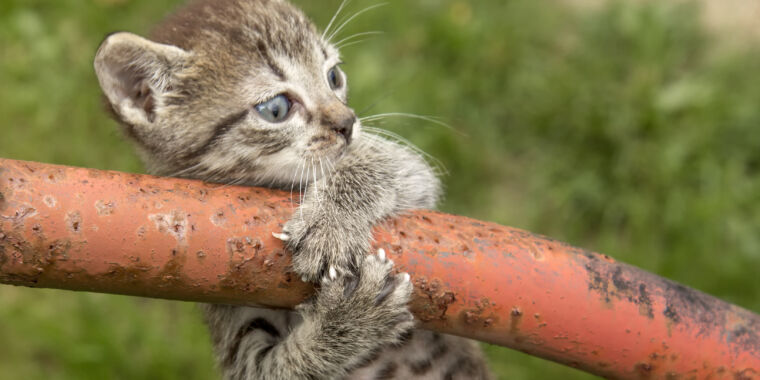Isaac Newton would never have discovered the laws of motion if he had only studied cats.
Imagine lifting a cat on its belly and dropping it out of a second-story window. If the cat were just a mechanical system obeying Newton’s laws of motion, it would land on its back. (There are technical issues, like having to do this in a vacuum, but we’ll ignore those for now.) Instead, most cats avoid injury by twisting their bodies as they land so that they land on their feet.
Most people aren’t amazed by this feat. We’ve all seen videos demonstrating cats’ acrobatic feats. But for over a century, scientists have puzzled over the physics of how cats do it. Apparently, there are no mathematical theorems that analyze a falling cat as a mechanical system. Not suitable for live catsNobel Prize winner Frank Wilczek points this out in a recent paper.
“This theorem does not apply to actual biological cats,” writes Wilczek, the MIT theoretical physicist: cats are not closed mechanical systems and can “consume stored energy… to power their mechanical movements.”
And yet the laws of physics apply to cats, and to every other animal, from insects to elephants. Biology doesn’t avoid the laws of physics, it embraces them. From friction on the microscopic scale to the fluid dynamics in water and air, animals use the laws of physics to run, swim, and fly. Every other aspect of animal behavior, from breathing to building shelters, depends in some way on the constraints imposed by, and the opportunities allowed by, physics.
“Organisms… are systems whose behavior is constrained by physics across multiple length and time scales,” Jennifer Reaser and co-authors wrote. Annual Review of Condensed Matter Physics.
Although the field of animal behavior physics is still in its infancy, great strides have been made in explaining individual behaviors and how those behaviors are shaped through interactions with other individuals and the environment. In addition to learning more about how animals perform diverse skills, such studies can also lead to new physics knowledge gained by probing animal capabilities that scientists do not yet understand.
Moving creatures
Physics applies to animals that behave at a variety of spatial scales. At the smallest end of the range, attractive forces between nearby atoms enable geckos and some insects to climb walls and walk on ceilings. At slightly larger scales, texture and structure provide adhesion for other biological movements. In bird wings, for example, tiny hooks and barbs act like Velcro, holding the feathers in place and increasing lift during flight, Reeser and his colleagues report.
An organism’s texture promotes friction between its parts and surfaces, aiding movement. California kingsnakes have texture on their scales that allows them to glide quickly forward, but increases friction, slowing backward or sideways movement. Recent research suggests that some snakes that move laterally may have evolved a different texture that reduces friction in the direction of movement.
Microstructures are also important for how animals interact with water. In many animals, these make their bodies “superhydrophobic,” blocking water penetration. “In humid climates, the shedding of water droplets is essential for flying animals, such as birds and insects, where weight and stability are crucial,” say Rieser and his co-authors Chantal Nguyen, Orit Peleg, and Calvin Rieska of Emory University.
A waterproof surface also helps keep the animal’s skin clean. “This self-cleaning mechanism is important for protecting the animal from hazards such as skin-borne parasites and other infections,” the Annual Review authors explain. And in some cases, it may be necessary to remove foreign objects from the animal’s surface to maintain the surface properties that enhance camouflage.


